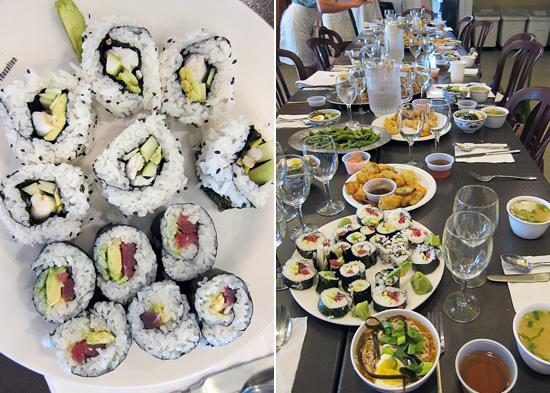ICE offers one of the country’s largest recreational cooking programs. With over 1,500 cooking classes and over 22,000 students each year, there is something for every cook looking to learn new techniques in the kitchen. This month, Cara Eisenpress and Phoebe Lapine of the blog Big Girls, Small Kitchen and the cookbook In the Small Kitchen tried a class on Essentials of Japanese Cooking with Chef Instructor Youngsun Lee.
They took their “grown-up meals made with limited resources” approach to the culinary class and came back with a whole new set of skills. As newly minted experts (we just published our first cookbook, called In the Small Kitchen), it’s easy to get a little high on our cooking abilities. In our book and on our website, we’ve got recipes from all sorts of cuisines. Some dishes, like our Spinach Pie Quesadillas, are clearly bastardizations, built from trips to Mexico and Greece, and, more importantly, from the leftovers in our fridge. Others, like a Thai Beef Salad actually come from real experience eating beef salad in Thailand. In other words with three years of documented cooking experience — albeit amateur, home-cooking experience — under our belts, we really can say we're experts at hosting buffet parties for ten or wooing guys with our beer beef stew. But cooking Japanese food? Bona-fide Japanese cuisine, the cuisine it takes decades to master? The one where sushi masters can pick up exactly 81 grains of rice with their eyes closed? We surely are not experts in that. But, like every other challenge that comes our way, we figured we'd give it the old college try. Cut to a Tuesday morning. We’re hungry and huddled at the table of one of ICE’s cooking classrooms with Chef Youngsun, ready for our lesson in Essentials of Japanese Cooking. On the menu, Japanese 101 staples: dashi and miso soup, ramen and soba, sushi, negimaki, tempura and katsudon, and steamed buns with sweet azuki paste. We’ve both dabbled in ramen and soba for sure. But at making tempura and katsudon we’d be total newbies.
As Chef Youngsun split the class into groups, Phoebe and I fumbled. What did we want to make the most? Did we care as much about making tempura as eating it? Was it crucial that we take part in the dashi making, even though it didn’t have quite as much drama as katsudon? Pretty soon, we claimed places at the tables, grabbing aprons and marveling at the gorgeous facility, ample mixing bowls, and endless supply of dishtowels that we wouldn’t have to wash ourselves. Phoebe volunteered Cara, the sweets-maker of our twosome, for buns duty. Cara put Phoebe in charge of negimaki, primarily because neither of us could wait to try it. Chef Youngsun came over to warn us that the buns, from his grandmother’s recipe, had better be perfect. Cara nervously kneaded the milk- and butter-based dough, then put it aside to rest. Phoebe went head on with a whole beef tenderloin, slicing it thinly under the eyes of the chef, then pounding it even thinner so it could wrap up the scallion and cilantro, bake, and become our pined-for negimaki.
After our own hard work was done, we roamed the classroom to see what everyone else was wrapped up in. The tempura frying had started, and we couldn’t believe the technique: if you dipped most of your fingers into the batter along with the vegetable, we learned, you could actually stick your fingers into the bubbling oil without burning them (you stick them in so that you don’t just drop the veggies in from afar, which creates splatter and a mess). We tasted ramen broth so good we didn’t want to stop sipping, and taste-tested katsudon better than any from our favorite Midtown donburi joints. By the time everything was done — the buns filled and steamed, the soba rolled into chopstick-accessible bundles, the ramen bowls beautifully arranged — we were long since full. We took home lots of leftovers, inspiration, and just the tiniest bit of expertise. We’ll be practicing ramen, negimaki, and lots of buns in our own small kitchens soon!
Cara Eisenpress and Phoebe Lapine, Big Girls Small Kitchen






